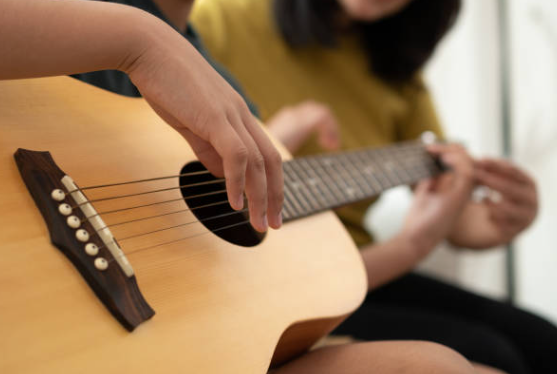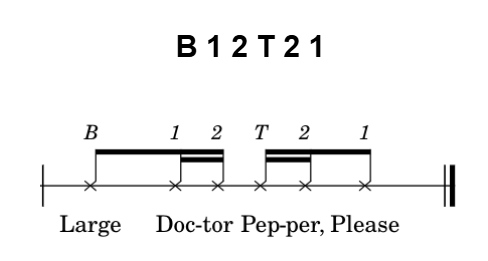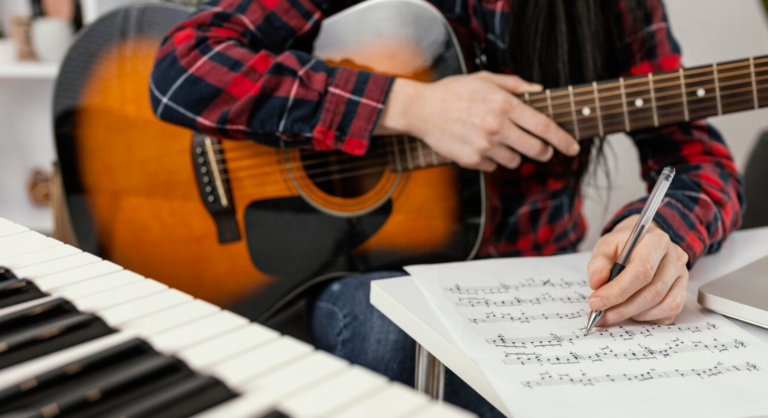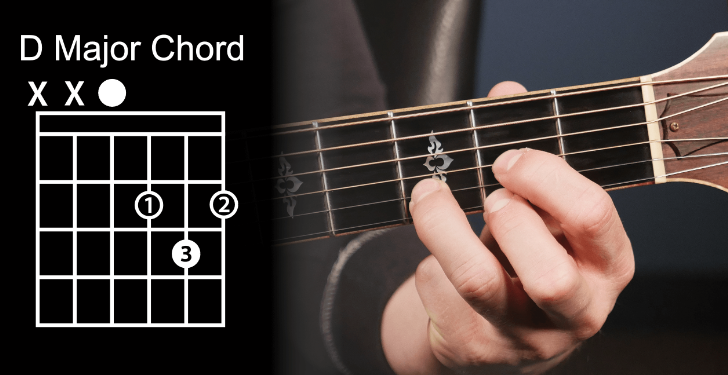Finger Picking Good

It’s 11 p.m. You just got off a gig and are heading home. You decide to pull into a Wendy’s for a quick snack. You ask for a Baconator Jr. and a small french fry. The voice on the drive-through intercom asks, “Anything else?” and you respond, “Large Dr. Pepper, please.”
Unbeknownst to you, the phrase you just chimed politely into the neon monolith of your eventual diabetic demise is the backbone of past and present folk music in America. What fun!
I’ll back up a bit.
You know that new Bob Dylan biopic? No Direction Home—no, wait, not that one. The newer one. A Complete Unknown. I haven’t seen it yet because I still haven’t seen Dune: Part Two, and I strive for Chalamet-continuity. But I have students who’ve seen it, and I hear it’s just great!
Growing up, my parents were big Bob Dylan and Simon & Garfunkel fans, so I had early exposure to the world of poetic, acoustic ’60s–’70s-era folk music. On its face, the genre is generally calming and pleasant to listen to. Digging a bit deeper, you find pain, heartache, political commentary, an entire social movement, societal transformations, and upheavals. I had a whole ’60s folk phase in high school, so I was thrilled when, a few weeks ago, my student told me she had seen Timothée Chalamet’s depiction of Bob Dylan in the now eight-time Academy Award-nominated movie and really, really wanted to learn the song “Don’t Think Twice, It’s All Right.”
Love that song. The perfect breakup song. I’m not a big lyrics guy, but these ones suck me in and spit me out. Bob Dylan’s lamenting, raspy vocals accompanied by thin, scurrying guitar chords—it’s a sardonic eulogy of love. 10/10. Also, check out the Chris Thile/Brad Mehldau version. It’s *chef’s kiss.*
Anyway. Right—Dylan, folk, guitar, acoustic, soda—FINGERPICKING.
The song starts out with a chordal reprise of what will eventually be heard as the end of the chorus, plucked on a lone acoustic guitar. Now, you could go to Ultimate Guitar and look up exactly how to play it, and indeed, doing so would probably bring you to the closest way of playing it exactly like Dylan recorded it. And you’d probably pick up some decent technique along the way. So you open the app or type the search into Google, and you see this:

And now you find yourself slowly and painstakingly parsing through each note in order, and, in my humble guitar-instructor opinion, that’s missing the forest for the trees. Are you learning the song because you NEED to know the EXACT sequence of strings that are plucked in the EXACT order with the EXACT nuance, or do you just like the song and want to play it? If you’re like me (or my student in this case), it’s the latter.
So we dive in. And for someone who is new to or unfamiliar with fingerpicking, I like to start them with the phrase “Large Dr. Pepper, please.” Go on, say it out loud. I can promise you with 99% certainty you said this:

You could also say something like “Big chicken sandwich, now” or “Crisp Caesar salad bowl.” In rhythmic notation, you’d be saying the same thing, which is “One and-a Two-e and.” Or, if you’re privy to South Indian Carnatic rhythmic solfège, “Ta Dimi Taka Di.”
Let’s translate it to the fingers, with the help of a shorthand key:
- T=Thumb
- 1=Index Finger
- 2=Middle Finger
- B=”Both” Thumb and Middle Finger
For each chord, we’re going to allocate one finger in the right hand (thumb, index, and middle) to one string on the guitar. For example’s sake, let’s place this on an open C Major chord. One thing we want to keep in mind is which string houses the lowest note. For C major, that would be the A string, so that’s where we’ll keep our thumb. The choice for the other two strings is somewhat arbitrary, but a common configuration is the G string and B string. We’re going to apply the “Large Dr. Pepper, please” rhythmic mnemonic to this sequence:

Start slow and deliberate, and build up the tempo as you begin to feel more comfortable. Ultimately, you’ll want to be able to execute this without thinking about your fingers at all. A good test is if you can speak out loud about what you had for breakfast that morning while maintaining a consistent pace in your fingerpicking. That’s how you’ll know you’re developing adequate muscle memory.
Something you’ll have to consider for this technique, as mentioned above, is the lowest note of each chord. The string that note lies on is where you’ll want to place your thumb. For example, A minor’s lowest note (or at least the root of the chord) is on the A string, so that’s where you’ll want to place your thumb. For D major, your thumb will be on the D string. For D/F#, your lowest note will be the second fret on the low E string, so that’s where your thumb will go.
This is one of the few guitar-playing techniques you don’t need an actual guitar to practice. We’re not training the fingertips here, merely the muscles in the hand and the base of the fingers. So really, all you actually need is a flat surface to tap your fingers on. The approach and methodology are the same—start slow, focus on lining up the correct movement in the sequence with the correct syllable from the mnemonic, and voilà—the next time you pick up the guitar, the muscle memory will kick in. Extrapolate to all the chords, alternate the thumb between the root and fifth of the chords (that’s another lesson in and of itself), and boom—you have effectively mastered folk guitar (sort of).
At its core, the technique is a style of fingerpicking known as Travis picking. Named for country guitarist Merle Travis, it features a rhythmic and steady picking pattern that alternates the thumb between bass notes while the fingers play melody or harmony on the higher-pitched strings. There are many adaptations of this technique that incorporate additional fingers, modify the thumb pattern, or traverse different strings, but its fundamental approach remains widely used. You’ve almost certainly heard Travis picking in one form or another without knowing its name. Some of the most well-known songs that showcase this technique include “Dust in the Wind” by Kansas, “The Boxer” by Simon & Garfunkel, and “Blackbird” by Paul McCartney.
So there you have it—next time you’re at a drive-through ordering your late-night feast, remember that you’re not just fueling up; you’re laying the rhythmic foundation of American folk music. Fingerpicking, especially in the Travis style, is less about memorizing an exact sequence of notes and more about internalizing a feel, a groove, a pulse. It’s about developing muscle memory so that your fingers can tell the story as effortlessly as your voice orders that Large Dr. Pepper. So tap it out, start slow, and let it sink in. Before you know it, you won’t just be playing “Don’t Think Twice, It’s All Right”—you’ll be feeling it.
Interested in taking your guitar skills to the next level? Click the below and book a free lesson with us! We’re committed to helping you express yourself freely on the guitar without endless scales and theory. Happy playing!
Author: Daniel Powers Jr, the founder of Real Brave™, serves as the chief inspiration to thousands of students in the Real Brave music instruction program. He’s also the visionary behind PracticePad™, an online platform for live one-on-one online music lessons, lesson tracking, and scheduling. Beyond his entrepreneurial pursuits, Daniel leads a non-profit organization that provides formerly homeless children with access to music education, making a profound impact on their lives. His unwavering dedication to music, innovation, and education continues to inspire individuals to reach their fullest potential while creating positive change in communities. Follow Real Brave on all the socials:
youtube.com/@realbraveinc
twitter.com/realbraveinc
https://www.tiktok.com/@realbraveinc
instagram.com/realbraveaudio
facebook.com/realbraveinc






